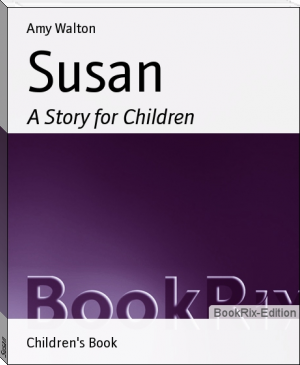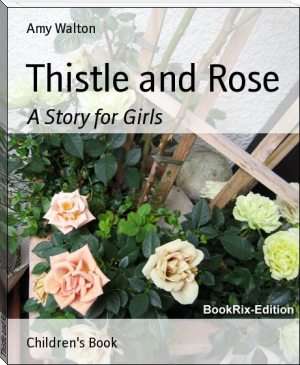author - "Amy Walton"

This is another story by Amy Walton about life in the English countryside towards the end of the nineteenth century. It is a sequel to "The Hawthorns", except that, for some reason, the name has become "Hawthorne". On the whole the principal dramatis personae, the Hawthorne household, are unchanged. The additions are Miss Barnicroft, an eccentric old lady from the village; Kettles, an impoverished child from Nearminster, the cathedral city close by; Dr Budge, a learned old

This charming little book was expressly written for younger children, aged about 11 or 12. There's plenty in the book for children of that age to enjoy, but older children might be a bit impatient. Susan and her family live in London, but she has a brother of ten years old who has a nasty chronic illness, and is bed-ridden. His family are advised to take him for the rest of the winter to a warmer climate, so his mother takes him to Algiers. During this interlude Susan is to go to stay with a

This is a nice little book, which would certainly appeal to its intended audience of eleven- or twelve-year-old little girls. Its background is distinctly late Victorian, but nevertheless a modern child would find nothing it could not relate to other than the more pleasant general atmosphere of those days.

A gently moving story for girls. Anna is aged fifteen, and her father needs to go abroad on business for a while. Her mother had died before Anna could remember. Anna is to go to Dornton to stay while her father is away, and she is looking forward to meeting her relatives, including her grandfather, who had been estranged from her father for many years. The grandfather is living quietly in a small house "with no servants" and has a job as organist in Dornton church. He is well-known

Frank thinks life at home is a bit hard, as his father expects so much of him, so he runs away. After several adventures he finds himself in a very awkward situation, as the young companion he had fallen in with turns out to be a thief. Luckily the thief's victim realises that Frank is not a bad lad after all, makes no charge against him, and even takes him home. So all is well that ends well. For the most part the other stories have a moral to tell, but they are all charming, and you will

Mrs White had had several children before the birth of this one, but they had all died. This makes her quite determined to make sure that this one survives. She was telling a visitor that she thought of calling the baby Annie, in honour of the visitor, but she had just been saying how much she loved white lilacs, and her husband had brought a branch of it over from a nearby village. So the visitor said, call her Lilac White, as there were already too many Annie Whites in the village.

Some young children, whose parents are working in India, are being brought up by an aunt in a small English village called Fieldside. The aunt lets them have a lot of freedom, but there are some "Rules of the House" which must be obeyed. When the cat has some lovely kittens, one black, on white, and one grey, they are not allowed to keep them, because there would then be too many cats than the Rules allowed, but they are given three weeks in which to find homes for them. How these

In the first of the stories a young girl-child is stolen by the gypsies. Yet they decide to give the child up, and they leave it in an out-house owned by a young clergyman. The latter isn't very pleased at this, but his wife certainly is, and they bring the child up. After a few years, and in a particularly tense moment, the true mother is found. An agreement is reached, whereby the child is shared. As with Amy Walton short stories, there is not only a well-told tale but also a moral.

This is another story by Amy Walton about life in the English countryside towards the end of the nineteenth century. It is a sequel to "The Hawthorns", except that, for some reason, the name has become "Hawthorne". On the whole the principal dramatis personae, the Hawthorne household, are unchanged. The additions are Miss Barnicroft, an eccentric old lady from the village; Kettles, an impoverished child from Nearminster, the cathedral city close by; Dr Budge, a learned old

This charming little book was expressly written for younger children, aged about 11 or 12. There's plenty in the book for children of that age to enjoy, but older children might be a bit impatient. Susan and her family live in London, but she has a brother of ten years old who has a nasty chronic illness, and is bed-ridden. His family are advised to take him for the rest of the winter to a warmer climate, so his mother takes him to Algiers. During this interlude Susan is to go to stay with a

This is a nice little book, which would certainly appeal to its intended audience of eleven- or twelve-year-old little girls. Its background is distinctly late Victorian, but nevertheless a modern child would find nothing it could not relate to other than the more pleasant general atmosphere of those days.

A gently moving story for girls. Anna is aged fifteen, and her father needs to go abroad on business for a while. Her mother had died before Anna could remember. Anna is to go to Dornton to stay while her father is away, and she is looking forward to meeting her relatives, including her grandfather, who had been estranged from her father for many years. The grandfather is living quietly in a small house "with no servants" and has a job as organist in Dornton church. He is well-known

Frank thinks life at home is a bit hard, as his father expects so much of him, so he runs away. After several adventures he finds himself in a very awkward situation, as the young companion he had fallen in with turns out to be a thief. Luckily the thief's victim realises that Frank is not a bad lad after all, makes no charge against him, and even takes him home. So all is well that ends well. For the most part the other stories have a moral to tell, but they are all charming, and you will

Mrs White had had several children before the birth of this one, but they had all died. This makes her quite determined to make sure that this one survives. She was telling a visitor that she thought of calling the baby Annie, in honour of the visitor, but she had just been saying how much she loved white lilacs, and her husband had brought a branch of it over from a nearby village. So the visitor said, call her Lilac White, as there were already too many Annie Whites in the village.

Some young children, whose parents are working in India, are being brought up by an aunt in a small English village called Fieldside. The aunt lets them have a lot of freedom, but there are some "Rules of the House" which must be obeyed. When the cat has some lovely kittens, one black, on white, and one grey, they are not allowed to keep them, because there would then be too many cats than the Rules allowed, but they are given three weeks in which to find homes for them. How these

In the first of the stories a young girl-child is stolen by the gypsies. Yet they decide to give the child up, and they leave it in an out-house owned by a young clergyman. The latter isn't very pleased at this, but his wife certainly is, and they bring the child up. After a few years, and in a particularly tense moment, the true mother is found. An agreement is reached, whereby the child is shared. As with Amy Walton short stories, there is not only a well-told tale but also a moral.
